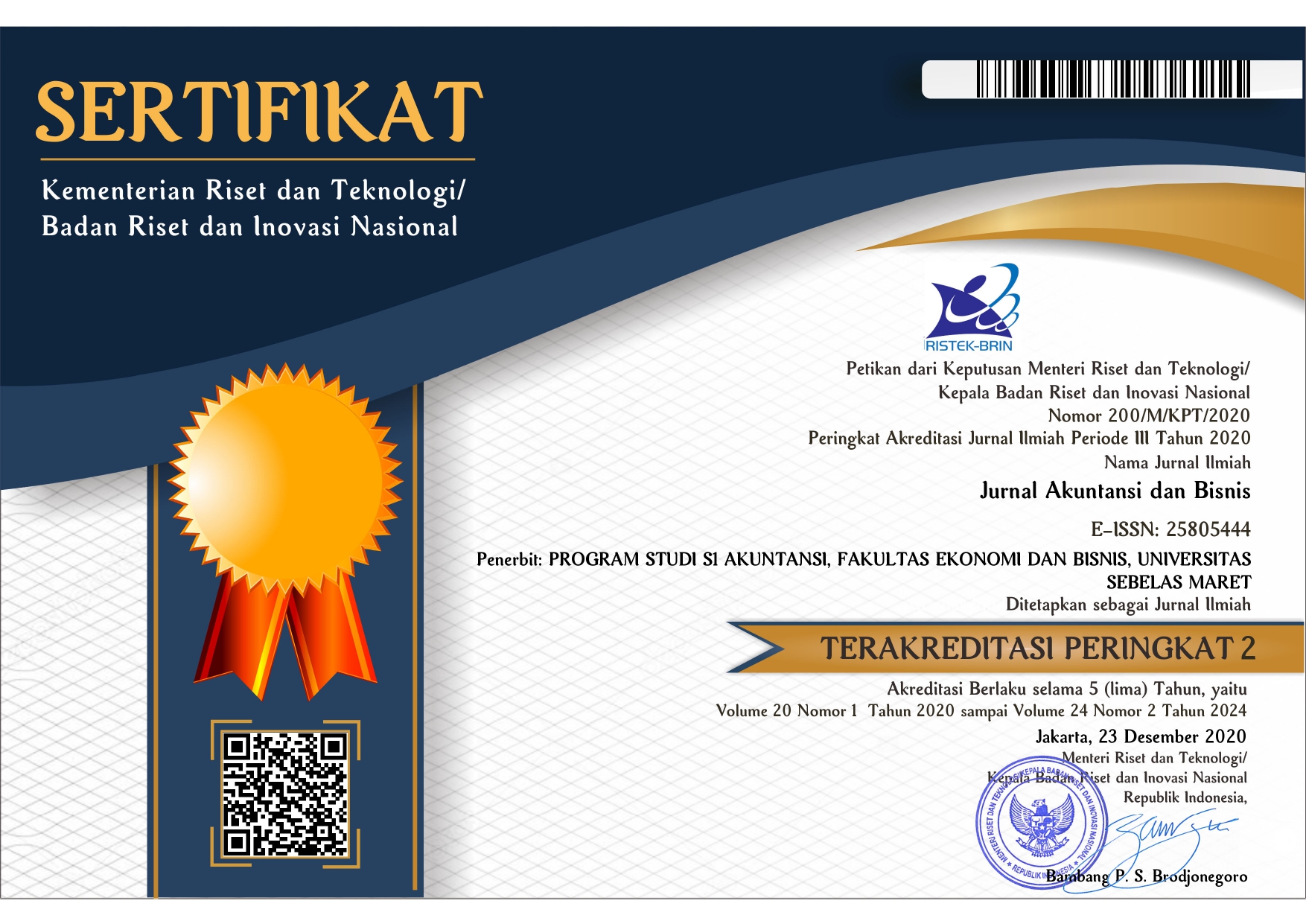The Effect of Corporate Diversification, Customer Concentration on Tax Avoidance in Indonesia
Abstract
Keywords
Full Text:
PDFReferences
Alm, J. (2012). Measuring, explaining, and controlling tax evasion: lessons from theory, experiments, and field studies. International Tax and Public Finance, 19(1), 54–77.
Arianandini, P. W., & Ramantha, I. W. (2018). Pengaruh Profitabilitas, Leverage, Dan Kepemilikan Institusional Pada Tax Avoidance. E-Jurnal Akuntansi Universitas Udayana, 22(3), 2088–2116.
Arieftiara, D., Utama, S., Wardhani, R., & Ning, R. (2015). Analisis pengaruh strategi bisnis terhadap penghindaran pajak, bukti empiris di Indonesia. Simposium Akuntansi Nasional XVIII, 18(1), 1–27.
Azizah, N., & Kusmuriyanto (2016). The effect of related party transaction, leverage, commissioners, and directors compensation on tax aggressiveness. Accounting Analysis Journal, 5(4), 307–16.
Baltagi, B. H. (2005). Econometric analysis of panel data, third edition. England: John Wiley & Sons.
Bentley-Goode, K. A., Omer, T. C., & Sharp, N. Y. (2013). Business strategy, financial reporting irregularities, and audit effort. Contemporary Accounting Research, 30(2), 780–817.
Campello, M., & Gao, J. (2017). Customer concentration and loan contract terms. Journal of Financial Economics, 123(1), 108–36.
Cobham, A., & Janský, P. (2018). Global distribution of revenue loss from corporate tax avoidance: re-estimation and country results. Journal of International Development, 30(2), 206–32.
Craig, W. (2015). Business Diversification: The Risk And The Reward. https://www.forbes.com/sites/williamcraig/2015/04/24/business-diversification-the-risk-and-the-reward/#35aa36087d09
Darmawan, I. G. H., & Sukartha, I. M. (2014). Pengaruh penerapan corporate governance, leverage, return on assets, dan ukuran perusahaan pada penghindaran pajak. E-Jurnal Akuntansi Universitas Udayana, 9(1), 143–61.
Dewi, N. L. P., & Noviari, N. (2017). Pengaruh ukuran perusahaan, leverage, profitabilitas dan corporate social responsibility terhadap penghindar pajak (tax avoidance). E-Jurnal Akuntansi Universitas Udayana, 21(1), 830–59.
Dhaliwal, D, Judd, J. S., Serfling, M., & Shaikh, S. (2016). Customer concentration risk and the cost of equity capital. Journal of Accounting and Economics, 61(1), 23–48.
Ferdiawan, Y., & Firmansyah, A. (2017). Pengaruh political connection, foreign activity, dan real earnings management terhadap tax avoidance. Jurnal Riset Akuntansi Dan Keuangan, 5(3), 1601-1624
Frank, M. M. Lynch, L. J., & Rego, S. O. (2009). Tax reporting aggressiveness and its relation to aggressive financial reporting. The Accounting Review, 84(2), 467–96.
Ghozali, I. (2013). Aplikasi analisis multivariate dengan program IBM SPSS 21, edisi 7. Semarang: Badan Penerbit Universitas Diponegoro.
Gosman, M. L, & Kohlbeck, M. J. (2009). Effects of the existence and identity of major customers on supplier profitability: is wal-mart different? Journal of Management Accounting Research, 21(1), 179–201.
Gu, L., Wang, Y., Yao, W., & Zhang, Y. (2018). Stock liquidity and corporate diversification : evidence from china’s split share structure reform. Journal of Empirical Finance.
Guenther, D. A., Matsunaga, S. R., & Williams, B. M. (2017). Is tax avoidance related to firm risk? The Accounting Review, 92(1), 115–36.
Hanlon, M., & Heitzman, S. (2010). a review of tax research. Journal of Accounting and Economics, 50(2–3), 127–78.
History.com Editors. (2009). Boston Tea Party. https://www.history.com/topics/american-revolution/boston-tea-party.
Huang, H., Lobo, G. L, Wang, C., & Xie, H. (2016). Customer concentration and corporate tax avoidance. Journal of Banking and Finance, 72, 184–200.
Huang, H, Sun, L., Zhang, J. (2017). Environmental uncertainty and tax avoidance. Advances in Taxation, 83–124.
Itzkowitz, J. (2013). Customers and cash: how relationships affect suppliers’ cash holdings. Journal of Corporate Finance, 19, 159–80.
Kirchler, E. (2007). The economic psychology of tax behaviour. New York: Cambridge University Press.
Kusuma, A. C., & Firmansyah, A. (2018). Manajemen laba, corporate governance, kualitas auditor eksternal dan agresivitas pajak. Jurnal Tekun, 8(1), 108-123.
Lestari, G. A. W, & Putri, I. G. A. M. A. D. (2017). Pengaruh corporate governance, koneksi politik, dan leverage terhadap penghindaran pajak. E-Jurnal Akuntansi Universitas Udayana, 18(3), 2028–54.
Lionita, A., & Kusbandiyah, A. (2017). Pengaruh corporate social responsibility, profitability, leverage, dan komisaris independen terhadap praktik penghindaran pajak pada perusahaan yang terdaftar Di BEI. Kompartemen: Jurnal Ilmiah Akuntansi, XV(1), 1–11.
Mankiw, N. G. (2012). Principles of Economics Sixth Edition. Sixth. Mason: South-Western Cengage Learning.
Marvin, M. J. (2019). Avoiding Higher Customer Concentration. https://gatewaycfs.com/bff/avoiding-high-customer-concentration.
Nachrowi, D. N., & Usman, H. (2006). Pendekatan Populer dan Praktis Ekonometrika untuk Analisis Ekonomi dan Keuangan. Fakultas Ekonomi Universitas Indonesia.
Oktavia, Kristanto, S. B., Subagyo, & Kurniawati, H. (2012). Transaksi hubungan istimewa dan pengaruhnya. Jurnal Akuntansi, 12, 701–16.
Puspita, S. R., & Harto, P. (2014). Pengaruh tata kelola perusahaan terhadap penghindaran pajak. Diponegoro Journal of Accounting, 3(2), 1–13.
Rachmawati, N. A. & Martani, D. (2014). Pengaruh large positive abnormal book-tax differences terhadap persistensi laba. Jurnal Akuntansi Dan Keuangan Indonesia, 11(2), 120–37.
Sari, D. K., Utama, S., Rossieta, H. (2017). Tax avoidance, related party transactions, corporate governance, and the corporate cash dividend policy. Journal of Indonesian Economy and Business Volume, 32(3), 190 – 208.
Ushijima, T. (2015). Diversification, Organization, and Value of the Firm. Financial Management, 467–99.
Wardani, D. K., & Khoiriyah, D. (2018). Pengaruh strategi bisnis dan karakteristik perusahaan terhadap penghindaran pajak. Akuntansi Dewantara, 2(1), 25–36.
Watts, R. L., & Zimmerman, J. L. (1986). Positive Accounting Theory. Englewood Cliffs, N.J.: Prentice-Hall.
Widarjono, A. (2013). Ekonometrika Pengantar Dan Aplikasinya. Jakarta: Ekonosia.
Wijayanti, A., Wijayanti, A., & Chomsatu, Y. (2017). Pengaruh karakteristik perusahaan, GCG dan CSR terhadap penghindaran pajak. Journal of Economic and Economic Education, 5(2), 113–27.
Zheng, S. (2017). Can corporate diversification induce more tax avoidance practices ? Evidence from the US Companies. Journal of Multinational Financial Management.
DOI: http://dx.doi.org/10.20961/jab.v19i2.475
Jurnal Akuntansi dan Bisnis (JAB)
ISSN 1412-0852 (print), 2580-5444 (online)
Published by Accounting Study Program, Faculty of Economics and Business, Universitas Sebelas Maret, Indonesia

JAB on http://jab.fe.uns.ac.id/index.php/jab is licensed under a Creative Commons Attribution-ShareAlike 4.0 International License










